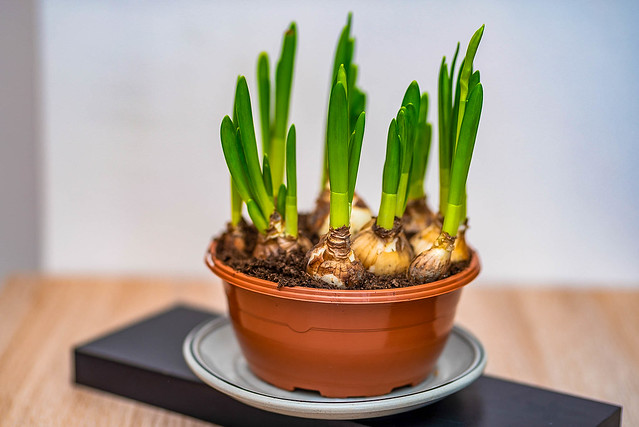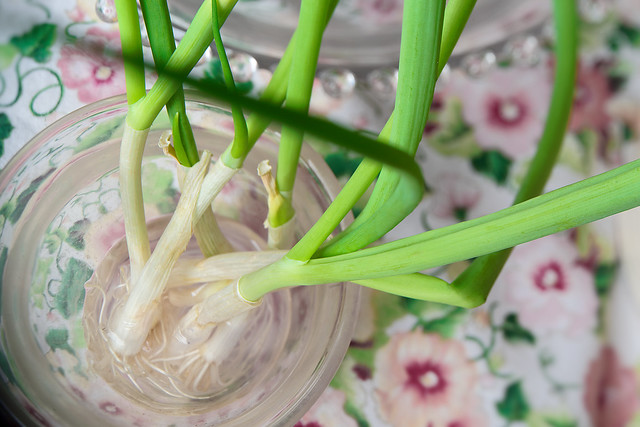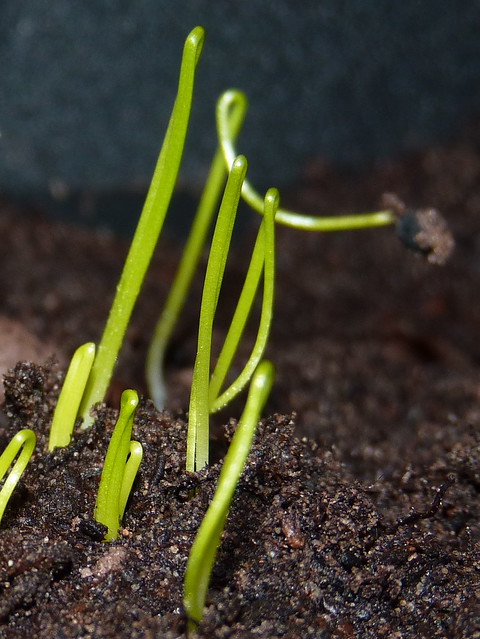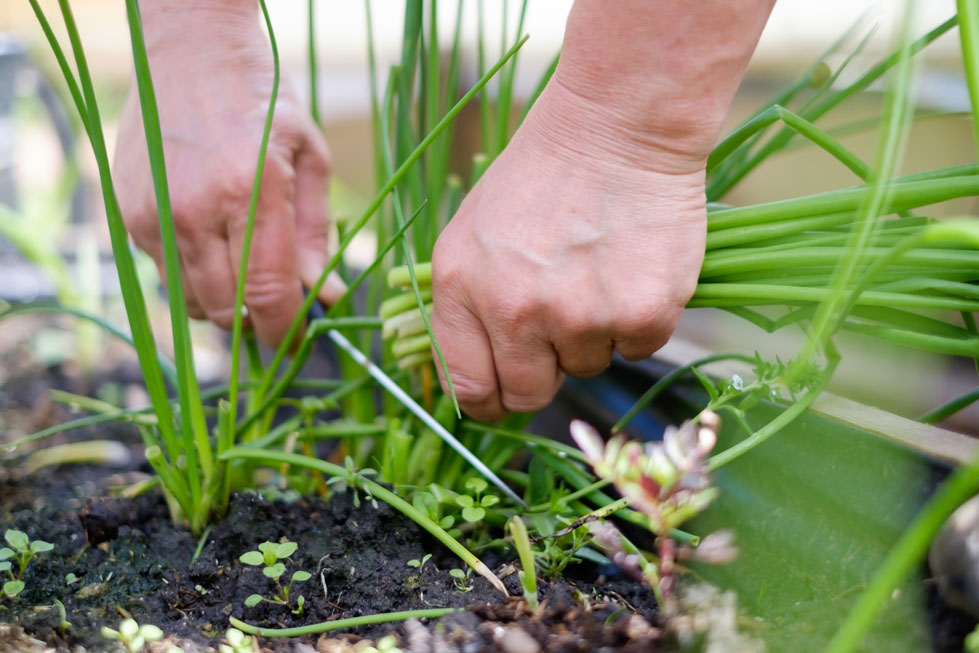You were probably curious how you can grow green onions for your braised beef or wonton soup.
Or you were probably obsessed with videos of highly skilled chefs incredibly chopping green onions so fast.

Green onions, also known as scallions, are commonly used in Asian, American and European cuisine. But it is most popular in Asian cuisine.
It is one of the oldest and most used ingredients in Chinese cooking.
A sprinkle of this slender vegetable elevates the flavor of the food through its sweetness and mildly onion taste.
That’s why I personally grow these in my garden. It’s perfect for a bowl of simple fried rice or dips.
Now, you might be wondering what’s the difference between green onions from scallion or green onions from spring onions?
They are actually the same; the only difference is the age upon harvesting. Both of them came from a specific species of a bulbing onion.
On the other hand, green onion is not the same as spring onions.
Although they are used interchangeably due to the strong resemblance in taste, green onions and spring onions are not the same.
Now that we’ve cleared that out; let’s dive into the white and green world of fresh green onions!
Things You Should Know About Growing Green Onions
Green onion is a low maintenance plant. It does not need much attention and caring than other plants, so it’s perfect for farming beginners like you.
In fact, this is one of my first ever planting projects.
It does not need a big space to grow. I even tried to grow it in pots and it still grew into sweet and mild lanky green onions.
The oldest and most effective trick I know in growing onions is to keep the soil always hydrated.
Although green onions are highly adaptive of the soil type and weather, the soil should always be moistened for green onions to thrive.

Green onions are actually baby onions. It is being harvested before it grows into a full grown onion, so the growing takes a little time than onions.
In 60-80 days upon seeding or transplanting, you could start harvesting the green onions of your labor.
Growing Green Onions – Step-by-Step
Let’s get your hands a little messy and dirty.
Here is a step by step guide to walk you through the process of planting and caring for a green onion.
How do I plant a green onion?
There are actually two ways to plant a green onion.
You could either do direct seeding or transplanting.
Although both processes will yield the same result, transplanting will be more convenient since you won’t have to start from scratch.
Easier, why? Well, because you could easily find these in grocery stores, so access would not be a problem.
Moreover, you could easily choose the healthiest among the bunch to yield the best results. Also, you would not go through the hassle of direct seeding.
Choose between the red, white, and yellow onion bulbs.
The taste of pungent and sweet taste varies among the three.
The yellow onions contain higher sulfur, so the taste is really pungent. White onions have a milder flavor, while the red one is the mildest and sweetest among the three.
I personally prefer the sweetest, so I usually go with the red one.
But it still depends on your own preference.
Just remember to go for the organic types instead of the typical since you are assured that these are free from chemicals and other harmful materials.
So head to the organic section and grab the healthiest green onion from the bunch.
It sure is a great investment, especially if this would be your ultimate source of green onions for the whole year.
How do I prepare this for planting?
Breaking news: you’re not supposed to plant the long vegetable directly to the soil.
A few steps should be taken to plant them directly to soil. So hide your gloves and gardening tools, we’ll start by preparing the products.
First, cut the stems approximately one inch higher from the base or the roots. If you prefer to go a bit higher, that’s okay. The whole idea is to cut the green part.
The lower part which is the one inch high stem from the roots will be used on planting.
The other half? You could just use it for your cooking. Add it into your dishes to add a mild yet oniony taste to your dishes.
Then, submerge the stems in water. This is not necessary, but I prefer to place them in water to hydrate the roots since onions need to stay hydrated at all times.
Just leave them in water for ten to fifteen minutes.
Where should I plant this?
Green onions are easily grown anywhere.
Its roots are very shallow, so it could grow in small pots and containers.
It could even thrive even in small plastic wares, so pots or area would not be an issue.
A shallow pot with no more than 6 – 8 inches deeps would suffice.
Meanwhile, there are no restrictions on the width of the container. As long as you place a 1.5 inches to 2 inches of spacing between the bulbs.
With this set-up you could grow up to 8 green onions in a 12-inch pot.
You should be cautious in using the containers that you’ve previously used for onions and garlic plants.
This might still carry diseases that could be susceptible to scallions.
What type of soil would work best for planting green onions?
The roots of scallions need moisture. That’s why rich well-draining soil suits green onions best.
This type of soil allows the draining of water in soil moderately.
This means that the soil does not result in puddling due to slow draining of soil or it does not dry out the soil due to fast draining.
This is to ensure that the roots are moisturized.
Before transferring the well-draining soil to the pot, make sure that the soil is free from weeds and rocks.
Then, loosen the soil by using your hand or a gardening fork. Remove weeds and rocks if there are still in the soil.
Since we will not be growing mature onions, a fertilizer will not be required. Compost and natural fertilizer would work.
I don’t use inorganic fertilizer as it easily dries out the rich materials in the soil which is contrary to moistened soil needed by green onions.
Make a mixture of compost and soil with ⅓ part dedicated for compost or organic fertilizer and the remaining ⅔ would be for soil.
Mix well for better distribution of nutrients in the soil.
I also add garden lime to my soil to soften the taste of the onion even more since lime neutralizes acidic soil.
And acidic soil is associated with bringing out the powerful pungent flavor of onions. If you want to make sure, you could also send a soil sample to testing sites.
How do I plant the green onions?
Now that you have ticked all the tasks in our to-do-list before planting, let’s start the real planting process.
After submerging the stems in water, plant the cut stems halfway with the roots facing downwards.
Half of the stem should be planted in the soil, while the other half above the soil. Make sure to leave 1-2 inches space between every stem.
Pat the surface of the soil for harder soil exterior, then water your pot generously and thoroughly. Place it in an area with great sunlight exposure.
Growing Green Onions
Really easy, right? You’ve just planted green onions.
You could just imagine now unlimited supply of green onions, but wait! Not so fast. You still have to maintain and take care of your plant for better results.

Do I need to thin my green onion plant?
Since we used the transplanting method instead of direct seeding, you won’t need to thin your plant.
The right distance of 2 inches has already been made when you transplanted the stalks into the soil.
Less work? Definitely! Just make sure that the soil is properly weeded because green onions do not work well with competition in nutrients.
How can I properly water my plant?
As I’ve mentioned a few times now, the roots of green onions should be moisturized at all times.
That’s why watering is fundamental. Make sure to water your plant regularly.
But how do you make sure that you are not overwatering your growing green onions?
Since green onions have a shallow root and our container is really shallow, you have to be cautious on the amount of water you are submerging the soil into, Just make sure that the surface is damp enough to maintain the moisture in the soil.
I also water the plant throughout the year, regardless of the season.
Which fertilizer should I use and when do I use it?
Scallions are easily grown in different types of soil and weather, so fertility of soil would not be an issue.
Compost or a mixture of decaying natural materials like leaves, grass, and vegetable peels is my personal choice when planting green onions.
It is multi-beneficial tin gardening since it provides nutrients, maintains moisture in soil, and it prevents pests and diseases from developing.
Moreover, you could also use different types of organic fertilizers like manure, alfalfa, and many more to increase the nutrients in your soil.
But do not use chemical fertilizer.
Aside from the harmful chemicals and materials that it could contain, chemical fertilizer also tends to dry out the soil which could, of course, result to unsuccessful plant project.
How much sun does my green onion plant need?
Just like other plants, green onions need enough amount of sunlight to get the best results.
Place your pots on areas that are directly exposed to sunlight.
Do not place it on shady places for it might slow the growth of your plant.
But if you don’t have another choice or if you’re growing it indoors, place the pot near the window to ensure that it is receiving direct sunlight for at least 4 hours.
When is the best time to grow green onions?
Since this is one of the low maintenance plants to grow, you could actually grow green onions throughout the year and seasons.
But, if you are feeling anxious about the end result and wanted to make all things the right way, this plant actually thrives more during fall up to early winter.
This type of plants require two temperatures in growing. It needs a cool weather to grow the top part, while a warm temperature for the bottom to grow.
You could also explore planting throughout winter until spring. It might just take a while to harvest since the sun is fundamental in their growth.
Which climate better suits garlic?
This plant takes advantage of the cool season. In fact, it has been qualified as a cool-season biennial plant.
This means that they continue to grow and produce leaves even during cold weather. They could grow from hardiness level 3 to 9. The germination is optimum on 52 F to 77 F.
So even if they need continuous exposure to sunlight to thrive, they also need a low temperature for germination and growth of leaves.
What are the growth stages of green onions?
Green onions or scallions are immature onions.
They are harvested even before they are grown mature bulbed onions. But what exactly would you expect between planting and harvest?
Basically, this plant is the first two stages of growing a mature onion. It is when the leaves are growing tall and the bulbs are not yet developed.
Within 30 days, you might already see the leaves growing up to 6 to eight inches. This is now ready to harvest.
What are the common diseases and pests that might affect a green onion plant?
Now that you are excited for your very first green onion harvest, let’s take a look at some of the pests and diseases that might hinder a successful harvest.
Since green onions are immature onion bulbs, the diseases they are mostly susceptible are also the same diseases of onions.
Here are some of the diseases you should look out for and ways to protect your green onion plant.
- Leaf Blight
This disease is caused by fungi called Botrytis squamosa. It affects the leaves of the plant with small white lesions with light green linings. The lesions could expand through time.
Old leaves are the most susceptible to this disease. That’s why it’s really important to regularly harvest the leaves.
To manage this disease, you could try to plant the green onions in one row to enable good air circulation. Replacing the soil is also really important since fungi tend to stay on soil.
2. Downy Mildew
This disease is slightly similar to the leaf blight; it also affects the leaves of the green onion. It is also caused by fungi which are called Peronospora destructor.
The difference would be the appearance in the leaves. This one gives white to yellowish spots on the leaves. It turns leaves into pale and yellowish color which in turn makes the leaves look wilting and unhealthy.
This disease could be managed by crop rotation or planting different plants after the other. Also, this could be prevented if you use a well-draining soil to prevent over moisture in the soil.
3. Leafminers
Insects like the leafminer are the number one pest of green onions. This little black and yellow insect targets the leaves, leaving a thin and white trail in the leaves. It may also cause decrease yield.
These insects also leave mature larvae on the leaves, which might affect the next planting or the soil.
To prevent this from happening, make sure that the transplants or the leaves you bought from the grocery are free from leafminers.
To manage this, if you saw early symptoms on one of the leaves, remove the plant immediately.
You see when it comes to green onions, the quality of leaves is really important.
That’s why you have to take care of the color and the freshness of the leaves the most.
Also, always keep in mind that prevention is always better than cure. Ensure that all processes were done to prevent diseases and pests from infesting your crops to prevent costly and labor intrusive pesticide.
Now, what other crops could you plant next to green onions?
Onions are one of the best companion plants in the garden. They are natural pest repellent, so they could make insects other pests go away.
The best companions for onion would be from the cabbage family. This includes broccoli, Kale, Brussel Sprouts, and cabbage.
This is because the natural repelling power of onions works well with this variety of plants.
Aside from this, they are also great in keeping aphids, Japanese beetles, and rabbits away.
That’s why plants that are greatly affected by the mentioned pests are good companions for tomatoes, lettuce, strawberries, and peppers.
Companion planting is actually a great way for organic gardening. The use of plants as natural repellents replaces the need for chemical pesticides.
What other crops should I not plant next to green onions?
While we have established that green onions are a good companion for planting, some plants would not work well with them due to chemical incompatibility.
The flavor contamination could also be the case since onions are known to have a strong pungent taste.
All varieties of peas and beans should not be placed near onions.
Also, other types of onions should not be planted near a green onion since they might be vulnerable to onion maggots.
Time to Harvest
Now that we’ve gone through all the labor of growing your own green onions. It’s time to harvest the fruit of your labor.
I’m sure you’re excited as I am. But wait, read more here to learn the right time and right way to harvest green onions.

When should I harvest green onions?
After three to four weeks or more or less 30 days, you can now harvest your green onions.
Confused? Just make sure that the leaves are six to eight inches tall and you’re now ready for a harvest. No questions asked!
I usually harvest after 30 days because it’s best to harvest the leaves when they are still young and fresh.
Also, old leaves tend to be more susceptible to diseases.
How do I harvest green onions?
Now that you are sure that your green onions are ready for harvest, you are now ready to harvest your first green onions!
You could dig or pull the green onions from the soil. All you have to do is to loosen the soil near the plant by using a gardening fork.
Then, Gently pull the underdeveloped bulb of green onion from the soil.
Remove the discolored leaves to reveal the beautiful and fresh green onion leaves. Then, cut the uppermost part of the leaf stalk. Cut also the bulb from the plant.
Before storing it, you could also cut a portion on the lowest most part near the roots for another round of planting green onions.
Where should I store the harvested green onions?
Since green onions are mostly leaves and stems, it is most important to place it in a freezer.
This is to maintain the freshness and prevent it from wilting.
Green onions have a short shelf life so make sure to maintain the moisture of the crop and avoid heat. It may not be as good after five days.
My only recommendation to prolong the freshness of green onions is to place it in a jar of water then put it inside the refrigerator.




